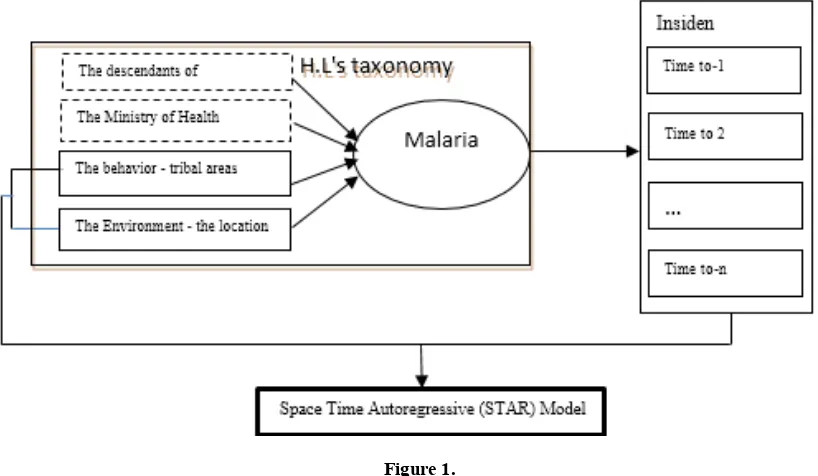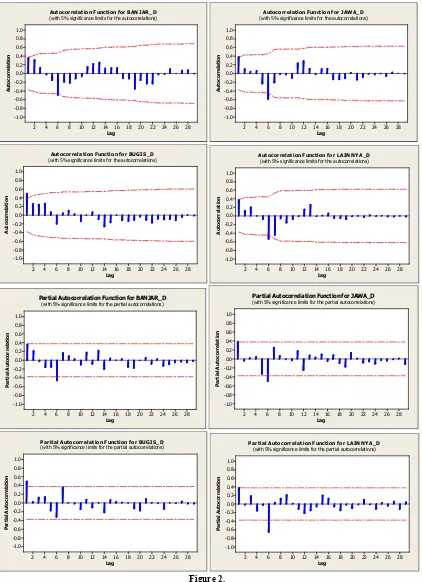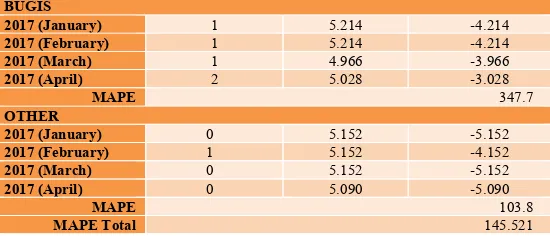© 2017, TextRoad Publication Journal of Applied Environmental and Biological Sciences
www.textroad.com
Corresponding author: Abdul Khair, Health Polytechnic Banjarmasin, Ministry of Health & Ph.D Student Faculty of Public Health, Airlanga University, Surabaya. Email: [email protected]
The Modeling of Malaria Cases Tribal Based in Tanah Bumbu Using
Space Time Autoregressive
Abdul Khair1*, Sarmanu 2, Santi Martini3, Bambang Widjanarko Otok4
1 Health Polytechnic Banjarmasin, Ministry of Health & Ph.D Student Faculty of Public Health,
Airlanga University, Surabaya
2 Prof. of Faculty Veterinary Medicine, Airlanga University, Surabaya,
3 Department of Biostatistics and Demography, Faculty of Public Health, Airlanga University, Surabaya, 4Laboratory of Environmental and Health Statistic, Institut Teknologi Sepuluh Nopember, Surabaya, INDONESIA
Received: June 17, 2017 Accepted: September 3, 2017
ABSTRACT
The number of Malaria in this area always has the tendency of the most compared to the city/another district in South Kalimantan Province. The discovery of cases of malaria in Tanah Bumbu on 2012 total 6044 cases from the total 29212 cases in South Kalimantan. The purpose of this research predicts the cases of Malaria in Tanah Bumbu tribal-based approach with space time autoregressive (STAR) model. The results of the study showed predicting the prevalence of Malaria is a model of the STAR (16;1) with the weight of the location of the uniform. The weight of the uniform of the prevalence
of Malaria, with constanta describe a correlation between ethnicity, therefore needed the weight of the other to examine the location of the tribal based.
KEYWORDS: Malaria, Tanah Bumbu, STAR, Uniform Weight
INTRODUCTION
Malaria is a disease that reemerging disease, occupying the sequence to the Tenth cause pain. Malaria also occupied the sequence of the 5 from six infectious disease that causes of death in the world. Malaria is the main cause of death tropical diseases each year there are 40 percent of the population in the world are at risk of suffering from the disease malaria or around 300-500 million cases. Estimated each year there is 1-3 million inhabitants of the world died because of the disease malaria [1].
The number of Malaria in Indonesia have declined significantly from 1990 until 2011, namely from 4.68, per thousand population at risk to 1.75 per thousand population at risk. Although visible a decline, but if seen from the absolute numbers are still large enough, namely 256592 people patients and only DKI Jakarta Province which is not found genesis Malaria. The mortality rate due to Malaria reached 1.3% [2]. In addition, on areas with high malaria cases, numbers Annual Parasite Incidence(API) is still very high compared to the national numbers and in areas with low annual malaria cases often extraordinary event occurs as the result of the case of import.
The number of death of Malaria reported in 2011 is 388 cases [3]. Incidence of malaria on the inhabitants of Indonesia 2013 is 1.9 percent decline compared to the year 2007 (2.9 percent), but in West Papua underwent a sharp increase the number of patients with malaria. The prevalence of malaria in West Papua 2013 is 6.0 percent. Morbidity Malaria population > 1 years old with an examination Rapid Diagnostic Test(RDT) is 1.3 percent with Plasmodium infections falcifarum most dominant compared to other species. The prevalence of Genesis Malaria 2013 of 6.0 percent [4].
South Kalimantan Province, if reviewed number from the diversity of Genesis Malaria 2011, a province with the number of Malaria sixth largest. The number of Malaria absolutely 2011 in South Kalimantan Province as much as 6663 Genesis [2]. If compared to the year 2007, then the incidence of malaria 2013 in South Kalimantan Province [5].
Tanah Bumbu is endemic areas malaria because in the last 3 years (2011 until 2013) always found cases of malaria. The number of malaria in this area always has the tendency of the most compared to the city/another district in South Kalimantan Province. The discovery of cases of malaria in Tanah Bumbu on 2012 totaled 6044 cases from the total 29212 cases in South Kalimantan [5].
The results of research related to the genesis of malaria are the temperature and humidity in research [6], [7], [8], and [9], the height of the location in research [10], Biological Environment in research [11], [12] the socio-economic research in the [11], [13], [14], and [12], the behavior in research [15], [11], [16].
The modeling of divination genesis disease based on time and location is the modeling space time (STAR). Space of time is a model that can be used to describe the existence of the influence of space and time (STAR). This model describes and predicts a n observation time order simultaneously. While the relationship between the area that shows the effects of time is realized in the form of a matrix weight [17].
Research and modeling of divination genesis diseases with STAR are done by [18], [19], and [20]. However, model of divination that obtained in the three research is considering only the case of previously according to time and location as the
variable wizards (predictors). Based on the need to be examined the predictions of malaria cases in the district of land -based spices tribal areas with space time autoregressive model approach.
METHODOLOGY
The Unit of analysis in this research is data number of Genesis malaria per month according to the sub-districts which are recorded in the system of recording and reporting on the health of Tanah Bumbu year 2012-2015. The basic concept in epidemiology often termed the trias epidemiology provides the relationship between the three main factors that have a role in a disease and other health problems, namely pejamu (host), agent (agent), and the environment (environment). The three factors is a dynamic unity in the balance (equilibrium) on the healthy. If the balance is disrupted, will cause the status of the sick [21]. Based on the research and theoretical studies description, then the framework of the concept of the research is presented in Figure 1.
Figure 1.
The Conceptual Framework of Genesis Malaria based on the tribal areas with STAR Model
Genesis malaria can had been modeled according to the theory of H.L. 'S taxonomy. In the theory of Genesis a disease can be influenced by 4 (four) factors, factors, descendants of health services, the behavior and the environment. Specific locations have certain environmental factors that can be different from the other locations. So the variables can be used as location are typical of a genesis pain. Behavior is internalisasi factor from the level of knowledge, attitudes and actions of a person who influenced by customs, customs and belief in certain things that has been handed down by his ancestors. The behavior of a community group can be different from the other groups so that they formed a group behavior or can be said tribal behavior. Incidents or genesis a disease according to the time will be able to form a specific model. The model can be used to predict the future events that will come. Considering the location and [22] develop models STAR. Community groups in Tanah Bumbu become heterogeneous community groups that can have a specific tribal behavior. This tribal behavior patterns will be used in the development of the model of the star in predicting genesis malaria in Tanah Bumbu.
The steps to get the model of the STAR best on the implementation of the data genesis malaria in Tanah Bumbu, namely determine the weight of the uniform, uniform weight Matrix can be symmetric or skewing, determine the Model Time series Univariat, determine the model of Space-time, Assessments time parameters and the location of the use of the smallest square method, examination conditions kestasioneran model of space-time, (eigen values from the matrix of parameters < 1), validation model of the space-time training data and testing data. Then can be done divination genesis malaria in Tanah Bumbu for some period into the future.
RESULTS AND DISCUSSION
28 (with 5% significance limits for the autocorrelations)
28 (with 5% significance limits for the autocorrelations)
28 (with 5% significance limits for the autocorrelations)
28 (with 5% significance limits for the autocorrelations)
28
Partial Autocorrelation Function for BANJAR_D (with 5% significance limits for the partial autocorrelations)
28
Partial Autocorrelation Function for JAWA_D (with 5% significance limits for the partial autocorrelations)
28
Partial Autocorrelation Function for BUGIS_D (with 5% significance limits for the partial autocorrelations)
28
Partial Autocorrelation Function for LAINNYA_D (with 5% significance limits for the partial autocorrelations)
Figure 2.
ACF and PACF plots Differencing 6 Prevalence of Malaria based on ethnicity
Figure 2, shows the ACF and PACF plots in each tribe, the lag 6 (seasonal) that significant so that based on the results of the identification of order time is AR(1)6. So the model of the space of time that is recommended for data Z(t) is the
6
STAR(1 ;1), space-time seasonal auto regressive order AR model 1 seasonal 6 and spatial order is a lag 1.
1 1 1
After the identification of the stage, the next step is to make the estimation of the model of the STAR(1 ;1)6 with the weight of the location of the uniform. The significance of the model used test statistics F is presented in Table 1.
Table 1.
The simultaneous test Model of the STAR(1 ;1)6
Variable Sum of Square df Mean of Square F P-value
Table 1 shows that the significant model with α=5%, value p-value = 0.000 smaller than α. This shows the form of the model of the STAR(1 ;1)6 the weight of the location of the uniform with the parameters of time and location is significant and can be applied on the tribal data in Tanah Bumbu. The results of the estimation with the smallest square method is presented in Table 2 [23].
Table 2.
Partial test Model of the STAR(1 ;1)6
Variable Coeffiecient Standard Error T- Statistic P-value
No Constanta
The model of the STAR(1 ;1)6 with parameter coefficient (0.275) and (-0.337) qualify stationary i.e. , then the parameter is still inserted into the model. So obtained
Z(t) = 5.093 + 0.275Z(t-6) - 0.337WuZ(t-6) + e(t)
The result of uniform weight model prediction STAR(1 ;1)6 with constant of Malaria prevalence for Banjar, Javanese, Bugis and other tribes for observation of 37th to 40th is presented Table 3.
Table 3.
Testing Model of the STAR(1 ;1)6
BUGIS
MAPE Total 145.521
Table 3 shows that the smallest MAPE value of Malaria prevalence in the Banjars was 62.7990% and subsequently in the Java category of 68.7849%. This can be interpreted that the predicted results of Malaria prevalence have an accurate tendency in the Banjar and Java tribes.
CONCLUSION
The results of the study showed that the model of space-time tribal based on the prevalence of malaria give significant results. Prediction of the prevalence of Malaria is a model of STAR(1 ;1)6 with a constant and the weight of the location of the
uniform, is Z( )t =5.093 0.275+ Z(t−6) 0.337− WuZ(t−6) +e(t)then MAPE of 145.52%. The weight of the uniform of the
prevalence of Malaria, with constant a correlation between ethnicity. Because only determined based on the number of closest neighbors around a specific location. This is evident that as a partial test, penduga parameters for location significant.
REFERENCES
[1] Rubianti, I., Wibowo,T.A., Solikhah, 2009. Faktor-faktor Risiko Malaria Di Wilayah Kerja Puskesmas Paruga Kota Bima Nusa Tenggara Barat. Jurnal KESMAS, 3 No. 3, pp.162-232.
[2] Alisjahbana, AS, Tuwo, LD, Sardjunani, N, Prawiradinata, RS, Subandi, Sanjoyo, Hadiat, Darajati, W, Riyati, T, Iryanti, R, Ratman, DR, Jalal , F, Atmawikarta, A, Darmadji, D, Nurdin, MH & Mayangsari, P., 2012. Laporan Pencapaian Tujuan Pembangunan Milenium di Indonesia 2011, Kementerian Perencanaan Pembangunan Nasional/Badan Perencanaan Pembangunan Nasional (Bappenas), Jakarta.
[3] Kemenkes RI, 2013. Pedoman Tata Laksana Malaria. Jakarta: Kementerian Kesehatan Republik Indonesia
[4] Balibangkes, 2013. Riset Kesehatan Dasar. Jakarta: Kementerian Kesehatan Republik Indonesia
[5] Kemenkes RI, 2014. Pedoman Manajemen Malaria. Jakarta: Kementerian Kesehatan Republik Indonesia
[6] Harijanto, P., 2000. Malaria Epidemiologi, Patogenesis, Manifestasi Klinis, & Penanganan. Jakarta: Penerbit Buku Kedokteran EGC.
[7] Texier, G, Machault, V, Barragti, M, Boutin, JP & Rogier, C., 2013. Environmental Determinant of Malaria Cases Among Travellers, Malaria Journal, pp. 12:87.
[8] Zhao, X, Chen, F, Feng, Z, Li, X & Zhou, X-H., 2013. The temporal lagged association between meteorological factors and malaria in 30 counties in south-west China: a multilevel distributed lag non- linear analysis.
[9] Goswami, P., Murty, U.S., Mutheneni, S.R. & Krishnan, S.T., 2014. Relative Roles of Weather Variables and Change in Human Population in Malaria: Comparison over Different States of India. Public Library of Science (PLoS ONE), 9.
[10] Niazyan, L.G., 2014. Malaria Risk Stratification in Armenia. Electronic Journal of NATURAL SCIENCES, p.2(23).
[11] Bashar, K, Al-Amin, HM, Reza, MS, Islam, M, Asaduzzaman & Ahmed, TU 2012. Socio-demographic factors influencing knowledge, attitude and practice (KAP) regarding malaria in Bangladesh, BioMed Central Journal, pp. 12:1084.
[12] Alemu, K., Worku, A., Berhane, Y., & Kumie, A., 2014. Men Traveling Away from Home Are More Likely to Bring Malaria into High Altitude Villages, Nortwest Ethiopia. Public Library of Science (PLoS ONE), 9.
[14] West, PA, Protopopoff, N, Rowland, M, Cumming, E, Rand, A, Drakeley, C, Wright, A, Kivaju, Z, Kirby, MJ, Mosha, FW, Kisinza, S & Kleinschmidt, I., 2013. Malaria Risk Factors in North West Tanzania: The Effect of Spraying, Nets and Wealth, Public Library of Science (PLoS ONE), vol 8.
[15] Moore, SJ, Darling, ST, Sihuincha, M, Padilla, N & Devine, GJ., 2007. A Low-Cost Repellent for Malaria Vectors in The Americas: Results Of Two Field Trials in Guatemala and Peru, BMC Journal, pp. 6:101.
[16] Rulisa, S, Kateera, F, Bizimana, JP, Agaba, S, Dukuzumuremyi, J, Baas, L, Harelimana, JDD, Mens, PF, Boer, KR & Vries, PJD., 2013. Malaria Prevalence, Spatial Clustering and Risk Factors in a Low Endemic Area of Eastern Rwanda: A Cross Sectional Study, Public Library of Science (PLoS ONE), vol 8.
[17] Kartini, Susanto I, Pangadi, 2012. Analisis Ruang Runtun Waktu pada Data Kemiskinan, FMIPA, UNS Surakarta, pp.207:214.
[18] Niu, X.F, I.W, McKeague & J.B. Elsmer, 1996. Improving Climate Prediction Using Seasonal Space-Time Models.
[19] Gumanti, N.D, Sutikno & Setiawan, 2010. Penerapan Metode GSTAR dengan Pendekatan Spatio-Temporal untuk Memodelkan Kejadian Demam Berdarah. FMIPA ITS.
[20] Pahrudin, M., 2013. Spatio-Temporal Modeling untuk Prediksi Kasus Malaria dan Manajemen Pengendaliannya di Kabupaten Tanah Bumbu Propinsi Kalimantan Selatan. Tesis. FKM Unair, Surabaya.
[21] Maryani, L & Muliani R., 2010. Epidemiologi Kesehatan. Graha Ilmu. Yogyakarta, hal.135-136.
[22] Pfeifer, P.E dan Deutsch, S.J., 1980a. A Three Stage Iterative Procedure for Space Time Modelling. Technometrics, Vol. 22, Number 1, 35-47



